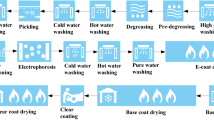Abstract
Specific energy consumption (SEC) also called energy intensity is one of the important aspects for lumber sawing sawmills since it represents the energy efficiency of the sawmill. Production, process, and energy data were gathered by visiting five sawmills out of which three sawmills had single sawing lines and two sawmills had double sawing lines. Sawmills with single and double sawing lines were selected in order to cover the different sawmill configurations. Data from sawmills 1, 2, 4, and 5 was used to develop an estimation model to estimate SEC of sawmill 3 based on the product, process, and system parameters. The independent variables that were included in the model were species, lumber sizes for the product, sawing time, maintenance schedule for the process, and motor horsepower, availability of resaw, and production line configuration for the system. Energy consumption of a motor on the demand side mainly depends on its capacity, operating hours, and load factor/efficiency ratio, and model 2 in this paper estimated SEC of a new sawmill from the product, process, and system parameters which represented the load factor/efficiency ratio when capacity and operating hours were known in the new sawmill. The product, process, and system parameters in model 3 represented motor capacity also along with the load factor/efficiency ratio and estimated SEC of a new sawmill. The developed regression models can be used to predict the sawing energy consumption of a new sawmill with reasonable accuracy.











Similar content being viewed by others
References
Cristóvão. (2013). Luís Cristóvão, Mats Ekevad, and Anders Grönlund, Industrial sawing of Pinus sylvestris L.: power consumption. BioResources, 8(4), 6044–6053.
EERE. (2012). US Department of Energy : Office of Energy Efficiency & Renewable Energy.
Engineering Toolbox. (2015). Wood densities. http://www.engineeringtoolbox.com/weigt-wood-d_821.html, http://www.engineeringtoolbox.com/wood-density-d_40.html. Accessed Mar 25, 2015.
Li, J., McCurdy, M., & Pang, S. (2006). Energy demand in wood processing plants. New Zealand Journal of Forestry, 51(2), 13–18. http://ir.canterbury.ac.nz/bitstream/10092/167/1/12603292_Main.pdf. (Accessed Jan 6, 2014).
Lin, W., Wang, J., Grushecky, S. T., Summerfield, D., & Gopalakrishnan, B. (2012). Energy consumption and efficiency of Appalachian hardwood sawmills. Forest Products Journal, 62(1), 32–38.
Matan, N., & Kyokong, B. (2003). Effect of moisture content on some physical and mechanical properties of juvenile rubberwood. Songklanakarin Journal of Science and Technology, 25(3), 327–340.
Mihai. (2008). Research concerning the workability by sawing of frozen and unfrozen spruce wood. PRO LIGNO - Open Access Scientific Journal in the Field of Wood Engineering, 4.
Montgomery, D., Runger, G. (2003). Applied statistics and probability for engineers, Chapter 6, Random sampling and data description, pp 189–219, Chapter 8, Statistical intervals for a single sample, pp 247–276, Third Edition John Wiley and Sons, Inc.
Payam, M., Doosthoseini, K., Scholz, F., & Tarmian, A. (2013). Cutting forces in bandsaw processing of oak and beech wood as affected by wood moisture content and cutting directions. European Journal of Wood and Wood Products, 71(6), 747–754.
Williston, E. (1988). Lumber manufacturing, Chapter 25, Saw design and maintenance (pp. 304–345, Revised Edition). Miller Freeman Publications, Inc..
Author information
Authors and Affiliations
Corresponding author
Ethics declarations
Conflict of interest
The authors declare that they have no conflict of interest.
Additional information
Publisher’s note
Springer Nature remains neutral with regard to jurisdictional claims in published maps and institutional affiliations.
Rights and permissions
About this article
Cite this article
Devaru, D.G., Gopalakrishnan, B. Regression model to estimate the electrical energy consumption of lumber sawing based on the product, process, and system parameters. Energy Efficiency 13, 1799–1824 (2020). https://doi.org/10.1007/s12053-020-09907-y
Received:
Accepted:
Published:
Issue Date:
DOI: https://doi.org/10.1007/s12053-020-09907-y




